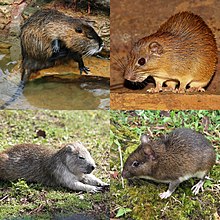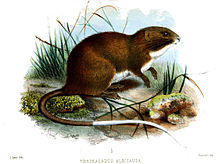Echimyidae
| Echimyidae Temporal range:
| |
|---|---|

| |
| Several members of the Echimyidae. From top-left, clockwise: . | |
| Scientific classification | |
| Domain: | Eukaryota |
| Kingdom: | Animalia |
| Phylum: | Chordata |
| Class: | Mammalia |
| Order: | Rodentia |
| Suborder: | Hystricomorpha |
| Infraorder: | Hystricognathi |
| Parvorder: | Caviomorpha |
| Superfamily: | Octodontoidea
|
| Family: | Echimyidae Gray, 1825 |
| Type genus | |
| Echimys F. Cuvier, 1809
| |
| Subfamilies | |
|
Capromyinae Echimyinae Euryzygomatomyinae Carterodontinae †Adelphomyinae † Eumysopinae †Heteropsomyinae | |


Echimyidae is the family
Characteristics
In general form, most spiny rats resemble rats, although they are more closely related to guinea pigs and chinchillas. Most species have stiff, pointed hairs, or spines, that presumably serve for protection from predators.
Many echimyids can
Most spiny rats are rare and poorly known, but a few are extremely abundant. Various species are respectively
Systematics
The current taxonomic content of the family Echimyidae has been reshaped over time, and its organization into coherent units stems from two realizations. The first is that
Extant genera
- Family Echimyidae - spiny rats
| Genus | Vernacular name | Molecular-based subfamily | Molecular-based tribe | Traditional systematics |
|---|---|---|---|---|
| Echimys | arboreal spiny rats | Echimyinae | Echimyini | Echimyinae |
| Phyllomys | Atlantic tree-rats | Echimyinae | Echimyini | Echimyinae |
| Makalata | — | Echimyinae | Echimyini | Echimyinae |
| Pattonomys | — | Echimyinae | Echimyini | Echimyinae |
Toromys |
giant tree-rat | Echimyinae | Echimyini | Echimyinae |
| Diplomys | — | Echimyinae | Echimyini | Echimyinae |
Santamartamys |
red-crested tree-rat | Echimyinae | Echimyini | Echimyinae |
| Isothrix | toros or brush-tailed rats | Echimyinae | Echimyini | Echimyinae |
| Dactylomys | bamboo rats | Echimyinae | Echimyini | Dactylomyinae |
| Olallamys | olalla rats | Echimyinae | Echimyini | Dactylomyinae |
Kannabateomys |
Atlantic bamboo rat | Echimyinae | Echimyini | Dactylomyinae |
Lonchothrix |
tuft-tailed spiny tree-rat | Echimyinae | Echimyini | Eumysopinae |
| Mesomys | spiny tree-rats | Echimyinae | Echimyini | Eumysopinae |
Callistomys |
painted tree-rat | Echimyinae | Myocastorini | Echimyinae |
| Myocastor | coypu, nutria | Echimyinae | Myocastorini | Myocastoridae |
| Thrichomys | punaré | Echimyinae | Myocastorini | Eumysopinae |
Hoplomys |
armored rat | Echimyinae | Myocastorini | Eumysopinae |
| Proechimys | spiny rats | Echimyinae | Myocastorini | Eumysopinae |
Trinomys |
Atlantic spiny rats | Euryzygomatomyinae | — | Eumysopinae |
Euryzygomatomys |
guiara | Euryzygomatomyinae | — | Eumysopinae |
| Clyomys | — | Euryzygomatomyinae | — | Eumysopinae |
Carterodon |
Owl's spiny rat | Caterodontinae | — | Eumysopinae |
| Plagiodontia | — | Capromyinae | Plagiodontini | Capromyidae |
| Geocapromys | — | Capromyinae | Capromyini | Capromyidae |
| Mesocapromys | — | Capromyinae | Capromyini | Capromyidae |
Mysateles |
— | Capromyinae | Capromyini | Capromyidae |
| Capromys | Desmarest's hutia | Capromyinae | Capromyini | Capromyidae |
Extinct genera
- Family Echimyidae - spiny rats
- †Cercomys
- †Maruchito
- †Paulacoutomys
- †Proclinodontomys
- †Willidewu
- Subfamily †Adelphomyinae
- Subfamily †Heteropsomyinae - extinct West Indian echimyids
- †Boromys
- †Brotomys
- †Heteropsomys
- †Puertoricomys
- Subfamily Eumysopinae
- Subfamily Capromyinae - hutias
- †Hexolobodon
- †Hyperplagiodontia
- †Isolobodon
- †Rhizoplagiodontia
- †
About Chaetomys
The bristle-spined rat,
Phylogeny
The phylogenetic tree of the Echimyidae shows a major split between the subfamily
| Genus-level cladogram of the Echimyidae (including members of the family Capromyidae). | |||||||||||||||||||||||||||||||||||||||||||||||||||||||||||||||||||||||||||||||||||||||||||||||||||||||||||||||||||||||||||||||||||||||||||||||
| |||||||||||||||||||||||||||||||||||||||||||||||||||||||||||||||||||||||||||||||||||||||||||||||||||||||||||||||||||||||||||||||||||||||||||||||
| The cladogram has been reconstructed from mitochondrial and nuclear DNA characters.[14][15][16][17][18][19][20][21][5][6] The green bar shows the polyphyly of the arboreal taxa, due to closer affinities of Callistomys with Myocastorini rather than with Echimyini. The red bar shows the polyphyly of the fossorial taxa, due to closer affinities of Carterodon with Capromyidae rather than with Euryzygomatomyinae. Carterodon has recently (2019) been classified in its own subfamily Carterodontinae.[22] |
References and notes
- ISBN 9780520098534.
- ^ Gray, J. E. (1825). "Outline of an attempt at the disposition of the Mammalia into tribes and families with a list of the genera apparently appertaining to each tribe". Annals of Philosophy. 10: 337–344.
- ^ OCLC 62265494.
- ^ a b c Myers, P. "Echimyidae: spiny rats". Animal Diversity Web. University of Michigan. Retrieved 2013-01-06.
- ^ ISBN 978-84-941892-3-4.
- ^ PMID 28025278.
- .
- OCLC 62265494.
- OCLC 62265494.
- ^ Stehlin HG, Schaub S (1951). "Die Trigonodontie der simplicidentaten Nager". Schweizerische Paläontologische Abhandlungen. 67: 1–385.
- ^ Patterson, B.; Wood, A. E. (1982). "Rodents from the Deseadan Oligocene of Bolivia and the relationships of the Caviomorpha". Bulletin of the Museum of Comparative Zoology. 149: 371–543. Retrieved 2017-09-26.
- ^ Carvalho G (2000). "Substitution of the deciduous premolar Chaetomys subspinosus (Olfers, 1818) (Hystricognathi, Rodentia) and its taxonomic implications". Zeitschrift für Säugetierkunde. 65: 187–190.
- PMID 19192302.
- PMID 8728398.
- PMID 12450750.
- PMID 15683932.
- PMID 22327013.
- S2CID 83639441.
- ^ Loss, Ana; Moura, Raquel T.; Leite, Yuri L. R. (2014). "Unexpected phylogenetic relationships of the painted tree rat Callistomys pictus (Rodentia: Echimyidae)" (PDF). Natureza on Line. 12: 132–136.
- PMID 25115033.
- ^ Upham, Nathan S.; Patterson, Bruce D. (2015). "Evolution of Caviomorph rodents: a complete phylogeny and timetree for living genera". In Vassallo, Aldo Ivan; Antenucci, Daniel (eds.). Biology of caviomorph rodents: diversity and evolution. Buenos Aires: SAREM Series A, Mammalogical Research — Sociedad Argentina para el Estudio de los Mamíferos. pp. 63–120.
- ^ Courcelle, Maxime; Tilak, Marie-Ka; Leite, Yuri L. R. (2019). "Digging for the spiny rat and hutia phylogeny using a gene capture approach, with the description of a new mammal subfamily". Molecular Phylogenetics and Evolution. 136: 241–253.
